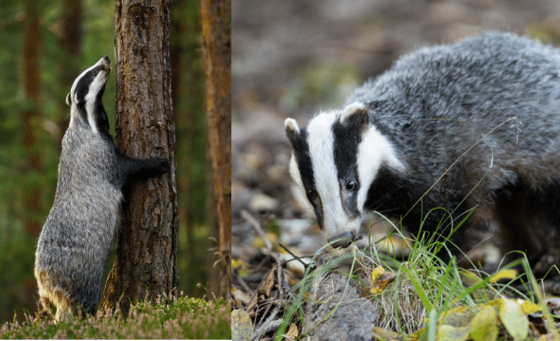

This question is hard to answer because of the vast number of birds, mammals, reptiles, and amphibians found here!
As you can imagine, there was no way to include every animal in the below article. So instead, I tried to focus on the most regularly seen and observed creatures.
#1. Roe Deer

Identifying Characteristics:
- Adults are 63–67 cm (about 2 ft) tall and weigh 15–35 kg (33–77 lb).
- Bucks grow 20–25 cm (8–10 in) long antlers with two or three points.
- They are ruddy brown, and fawns have white dapples on their backs.
Look for this animal in Lithuania in a variety of habitats.
The Roe Deer is a relatively small species that usually thrives in chilly weather. However, if they have adequate food and shelter, they will inhabit virtually any landscape, from tundra to warm grassland. Because of their small size, Roe Deer often spend daylight hours in the protection of dense forests, where they can hide from predators.

This species eats grass, leaves, and berries and has a special preference for very young plants that have received recent rain. So, the best place and time to see them is after heavy rain in a new field with young plants, around dawn or dusk. They rarely venture onto land that’s been grazed by livestock.
Roe Deer populations across Lithuania are steadily increasing, so there isn’t a current threat to their well-being. Despite being one of the top game species, it’s a species of least concern in conservation.

#2. Nutria

Identifying Characteristics:
- Adults weigh 4–9 kg (9–20 lb) and are 40–60 cm (16–24 in) long.
- They have brownish-gray fur with a white patch on the face.
- Their back feet are webbed, and their large, strong incisors are bright yellow.
Although they aren’t native animals in Lithuania, the Nutria is now the most plentiful semi-aquatic rodent in the region. This animal reproduces quickly and can destroy natural habitats, so it’s considered invasive throughout much of the world. Unfortunately, Nutria, which are also commonly called coypu, can also cause sickness in humans through water contamination.

Nutria, which are native to South America, look like large rats or small beavers with buck teeth and thin, naked tails. Depending on where you live, you might mistake this rodent for a muskrat, which looks similar in size and coloring. The main difference is that muskrats have flattened tails, while Nutria have round tails.
#3. Red Squirrel (Eurasian)

Identifying Characteristics:
- Adults are 19-23 cm (7.5-9 in) long.
- True to its name, this squirrel species has reddish fur. Their bellies are white, and their backs are sometimes more grayish.
- They have tufted ears and fluffy tails.
Red Squirrels are some of the cutest animals in Lithuania!
They have tufted, pointy ears, fluffy tails, and an adorably round belly covered in white fur. And these squirrels have more going for them than looks; they’re also very smart! They hide food in caches and go back for it during low-food seasons. Plus, they’re very smart about hiding from predators during hunting periods and only come out when it’s safe.

Unfortunately, Red Squirrels are not quite as dominant as the introduced Gray Squirrel, which is native to North America. In areas where Gray Squirrels have been introduced, they often take over and edge out Red Squirrels, causing the population to decline.
Despite the threat from other squirrel species, Red Squirrels are still well-established and have a sizable population across Lithuania.

#4. Wild Boar

Identifying Characteristics:
- Adults are 140–150 cm (55–59 in) long.
- Their heads are large for their bodies, and they have extremely short and thick necks.
- They have short, coarse hair that’s typically rusty brown, although older specimens sometimes have silvery hairs.
Wild Boars are the ancestors of most domesticated pig species, including typical farm pigs. But while they have the same basic body shape and a familiar flattened snout, the similarities end there!
For example, Wild Boars are some of the toughest animals in Lithuania.
They can dig in hard-packed earth and move rocks up to 40–50 kg (88–110 lb). This talent is handy because Wild Boars are extreme omnivores, meaning they’ll eat pretty much anything they can fit in their mouths! So, moving rocks to get to buried insects, small mammals, and roots is key.

Interestingly, the population of these mammals in Lithuania has fluctuated greatly over the last few centuries. Factors determining where Wild Boars can be found include climate, hunting habits, and land development. For example, during the late 1800s and early 1900s, hunting and poaching nearly eliminated some wild populations. However, conservation efforts and the accidental release of captive specimens have allowed their numbers to rebound significantly.
#5. Badger

Identifying Characteristics:
- Adults are 60–90 cm (24–35 in) long.
- They have black and white striped faces, black noses, and black or grayish body hair.
- Their teeth and claws are long, sharp, and yellowish-brown.
Badgers are one of the most adaptable animals in Lithuania.
These mammals may be on the smaller side, but they have powerful muscles and stout bodies that allow them to easily move around. They’re carnivores whose diet mostly consists of earthworms, insects, and small mammals, but they also eat plants and roots.

Badgers form groups of adults that control territory and defend their area for food gathering and building their nests. They build nests within complex burrows that can be 35–81 m (115–266 ft) long. These tunnels and underground rooms are where they spend most of the day. Then, at night, they emerge to hunt and socialize.
In addition to sharp teeth, claws, and strong muscles, Badgers are some of the most aggressive burrowing animals in Lithuania. They will fight back viciously against most predators, leading many to avoid them. Occasionally, brown bears, grey wolves, or other large carnivores will go after a badger. However, even these large animals prefer easier prey.

#6. Red Deer

Identifying Characteristics:
- Adults are 175 to 250 cm (69 to 98 in) long and weigh 160 to 240 kg (353 to 530 lb).
- Males have antlers that are an average of 71 cm (28 in) long, which they grow each year and shed in winter.
- Their coats are reddish brown in summer, and in winter, they are more gray.
There isn’t much about the Red Deer that isn’t impressive or intimidating!
These mammals are the fourth-largest deer species in the world.
In addition to their large size, males have imposing antlers that can grow incredibly long. Although most are smaller, the antlers of dominant males are known to grow up to 115 cm (45 in) long and weigh 5 kg (11 lbs).

Perhaps the most intimidating characteristic of Red Deer is the haunting, bellowing calls that males make during their mating season, also known as the rut. These calls are used to attract a mate and warn off potential competitors once a female has shown interest. Just listen below, and you’ll see what I mean!

#7. Northern White-Breasted Hedgehog

Identifying Characteristics:
- Adults are an average of 26 cm (10 in) long.
- They have a pointed, narrow snout and characteristic short spines all over the body.
- Their body shape is rounded, and their coloring is mottled grayish-brown with a lighter underside.
Northern White-Breasted Hedgehogs are one of the most recognizable animals in Lithuania! However, you’d be hard-pressed to tell the difference between this variety and the common European Hedgehog. From their sharply pointed noses to their short, spiny quills, they’re virtually indistinguishable.

This hedgehog has a large range and a stable population, which means they’re not a conservation concern at this time. In fact, it’s pretty common to see these fascinating creatures on an evening walk!
You’re most likely to observe White-breasted Hedgehogs at night when they tend to forage for insects. During the day, these mammals sleep in nests made of plant material. In colder climates, hedgehogs will hibernate over winter but usually wake a few times to move their nest.
#8. Fallow Deer

Identifying Characteristics:
- Adult males are 85–95 cm (33–37 in) tall at the shoulder, while females are much smaller.
- Their coloring is light brown on the back, with dappled white markings and stripes. Their undersides are white.
- They have small tails in shades of white, black, and brown.
Fallow Deer are common animals to see in Lithuania.
Because of their unique appearance, it’s unlikely that you’ll mistake this deer for any other type! For one thing, their antlers have a distinct plate-like shape, with flattened portions and points. In addition, their coats are variable in color and usually have many more markings, dapples, and stripes than other species. Finally, the most interesting thing about Fallow Deer is that the males are MUCH larger than the females.

Although Fallow Deer are native animals in Lithuania, they’ve been introduced to many other parts of the world. In most cases, such as in Australia and South America, these deer were imported as game species to be hunted. However, in some parts of the world, like Canada, they have become invasive and are detrimental to the native wild plants, which Fallow Deer readily eat.
Despite this worldwide spread and a stable population, Fallow Deer are disappearing from their native habitat. Many factors contribute to their decline, but land development and climate change are the key factors pushing out this fascinating species.
#9. Brown Hare (European Hare)

Identifying Characteristics:
- Adults are 60-75 cm (24-30 in) long and weigh 3-5 kg (6.6-11.0 lb).
- They have extremely long ears and back feet and muscular bodies.
- Their coloring is muddy brown on the back and face, with white fur on the chest and underside.
What’s the difference between a Rabbit and a Hare?
Although these two animals in Lithuania are part of the same family, some key differences can help you tell them apart. And no offense to rabbits, but hares are definitely the tougher animal! Because of their harsher habitats, European Hares have longer ears and limbs, they run faster and lunge further, and they can eat tougher foods than rabbits.

In particular, Hares can run up to 70 km/h (43 mph)! They have no problem outrunning most predators over open ground. As a result, Hares don’t burrow like rabbits because they don’t need protection. Instead, they rest in shallow depressions made by tamping down grasses or dirt.
If you’re looking for wildlife in Lithuania, this species is one you’ll almost definitely be able to find. Hares have a steadily growing population and a wide range, with few threats to their well-being.

#10. Red Fox

Identifying Characteristics:
- Adults range from 45-90 cm (18-35 in) in length and weigh 3-14 kg (7-31 lbs).
- Their coloring ranges from pale orange or red to deep reddish-brown on their upper parts, with white on their underside.
- They have black feet, a fluffy white-tipped tail, and large, pointy, black-tipped ears.
Red Foxes are arguably the most beautiful animal in Lithuania!
These canines are often considered cunning and smart, with good reason! They’re excellent hunters and foragers. They also cache food and are adept at relocating it. Although they prefer rabbits, fish, and berries, they won’t hesitate to eat anything readily available.

This species has a distinctive way of hunting mice and other small rodents. Once the prey has been detected, they stand motionless, waiting and listening. Then they leap high into the air and bring their forelegs straight down, pinning the rodent.
Once baby foxes, known as kits, reach adulthood, their biggest threat is humans. They are hunted and trapped for their or killed to protect chickens. While some countries have banned hunting Red Foxes, the practice still persists worldwide. Red Foxes can live 10 to 12 years in captivity but average only about three years in the wild.
#11. Elk (Moose)

Identifying Characteristics:
- Adults stand about 1.8 m (6ft) tall at the shoulder and weigh more than 450 kg (1,000 lbs).
- Their coloring is generally dark brown. Cows (females) have light brown faces and a white patch of fur beneath the tail.
- Elk have flaps of skin called dewlaps hanging from their throats, and bulls (males) grow massive antlers up to six feet across in the spring and summer.
Elk, the largest member of the deer family, only thrive in colder climates due to their massive size and insulated fur. Their hair is hollow, helping to trap air and provide maximum insulation. Their ideal habitat includes a mix of mature and young trees, which offers abundant forage.
In North America, this animal is called a “Moose,” an Algonquin term meaning “eater of twigs,” which is one of their favorite foods. During the summer, they also eat large quantities of aquatic plants. A single Elk consumes 25 to 45 pounds of vegetation per day.

Female Elk, called cows, are known to aggressively defend their young, which often have a high mortality rate until they turn one. Mothers have been known to injure or kill bears, wolves, and even people in defense of their babies. If you encounter an Elk with babies, stay as far away as possible to avoid injury.
Elk are highly susceptible to the effects of climate change. Warmer winters have resulted in higher tick infestations, causing Elk to die of blood loss and anemia. Tick infestations are believed to be the main cause of Elk populations dropping 40% in the last decade.
#12. Gray Wolf

Identifying Characteristics:
- Adults range from 1-1.5 m (3-5 ft) long and weigh 28-66 kg (62-145 lbs).
- Their coloring varies from solid white to black but is often a mix of gray and brown with light facial markings and undersides.
- They have long, bushy tails often tipped in black.
Gray Wolves are the largest living canine species! They thrive in various habitats, from tundra to woodlands, forests, grasslands, and deserts.
Wolves communicate through body language, barking, growling, howling, and scent marking within a pack. Howling may be used for long-distance communication, to call a pack back together, or to warn intruding wolves away. The alpha male and female are typically the only ones that mate, and they do so for life.

Gray Wolves were once widespread in Lithuania but were heavily hunted.
Today, Gray Wolves remain extinct in most of their former range. Fortunately, endangered species protection and reintroduction efforts have been successful.
Apex predators like wolves are incredibly important to ecosystems. Without them, there is an overabundance of large herbivores, which typically devastates native vegetation and increases erosion. Although some people find wolves scary, they’re an important part of nature!
#13. Mallard

Identifying Characteristics:
- Males have a bright green head, thin white collar, dark reddish-brown chest, yellow bill, and black tail feathers with white tips.
- Females are mottled brown with orange and brown bills.
- Both sexes have purple-blue secondary feathers on their wing, most visible when standing or flying.
My guess is that almost everyone is familiar with the Mallard. These ducks are the most common animals in Lithuania!
Mallards are extremely comfortable around people, which is why these adaptable ducks are widespread. They are found in virtually any wetland habitat, regardless of location.

Mallards readily accept artificial structures built for them by humans. If you have a nice pond or a marsh, feel free to put up a homemade nesting area to enjoy some adorable ducklings walking around your property! Make sure you put up predator guards so predators can’t get to the eggs.

When you think of a duck quacking, it is almost inevitably a female Mallard. If there is a better duck sound, we haven’t heard it! Interestingly, males do not quack like females but, instead, make a raspy call.

#14. European Robin

Identifying Characteristics:
- Their coloring is orange on the face and breast with slate-blue sides and neck. Their backs are tan, and their bellies are white.
- The beak and eyes are dark brown, while the feet and legs are light brown.
Robins are one of the most widespread animals in Lithuania!
You can find them across many habitats, but they are especially common visitors to backyards and gardens. The Robin is one of the most charming and popular birds in Lithuania. They have become tame and are a welcome sight in any backyard. Robins are even known to follow gardeners around! 🙂

They enjoy eating worms, but they will also eat seeds, other invertebrates and insects, fruit, and nuts. During the winter, they’re attracted to suet, especially if it contains mealworms.
You’re likely to hear European Robins singing at all hours of the day. They’re usually the first to start calling in the morning and the last to stop in the evening. Listen for a sweet, breathy song that turns up in pitch at the end.

#15. Common Chaffinch

Identifying Characteristics:
- Males are rust-colored, with green on the upper back. They have a gray cap that curls around the back of their head, surrounding the earhole, and looks like a shirt collar.
- Females are duller with a greenish-brown head, white tail feathers, and a green posterior.
- Both sexes have bright white stripes on their wings.
Common Chaffinches are incredibly common, mostly because they are so adaptable. Look for this small songbird in Lithuania in many habitats, such as forests, parks, and neighborhoods with lots of tree cover.

Chaffinches are incredibly common at bird feeders. They are most often seen on the ground cleaning up the seed that has fallen from above, with sunflower hearts being their favorite. These birds can become so tame in backyards that they flutter around people as they come outside, expecting to be fed or the feeders refilled!
- RELATED: 7 BEST Birding Tours in Europe!
Their song is so beautiful that a group of these birds is known as a “Charm!” Their songs usually contain a rattling series of notes that start high and lower toward the end.

#16. House Sparrow

Identifying Characteristics:
- Males are predominantly slate gray, with black stripes under the chin and from the beak to the eyes. In addition, they have brown “eyebrows” and brown, black, and white-streaked wings.
- Females are far plainer, mostly dull brown and gray.
House Sparrows are opportunistic birds that live across Lithuania.
Although populations of this animal in Lithuania are declining slightly, it has become invasive across much of the rest of the world, where it thrives with little competition and pushes out many native species.

In most urban and suburban areas, it’s INCREDIBLY COMMON to see House Sparrows. They owe their success to their ability to adapt and live near humans. Unlike most other birds, they love grains and are commonly seen eating bread and popcorn at amusement parks, sporting events, etc.
House Sparrows can be heard across the entire planet. Pay attention the next time you’re watching the news in another country. Listen for a simple song that includes lots of “cheep” notes.

#17. Common Blackbird

Identifying Characteristics:
- Males are entirely black with a bright yellow ring around the eyes. The beak is bright orange.
- Females and juveniles are mottled brown with yellowish-brown beaks. However, they still have a bright yellow eye ring.
The Eurasian or Common Blackbird is one of the most recognizable birds in Lithuania. Their preferred territories include gardens, wooded habitats, parks, and farmland with hedges. Look for them on lawns and fields, where they spend most of their time foraging insects and earthworms.

Like many blackbirds, this species is extremely territorial, especially during breeding. Look for squabbles and fights to break out regularly over food, nesting locations, and seemingly nothing at all!
Listen for the Eurasian Blackbird’s multi-toned warbling cry, which is easy to recognize, but harder to describe.

#18. Great Tit

Identifying Characteristics:
- A yellow belly with a distinctive black stripe running right down the middle of its chest, a jade back, and a black cap and collar that contrasts with its white cheek patches.
- Its wings are grey-brown with a flashy lateral white-yellow bar, and the tail is a black fan.
You’re almost guaranteed to see the Great Tit when observing wildlife in Lithuania.
They live throughout Lithuania in mixed forests, clearings, and dense woodlands. They have a particular affinity for people, and you’ll often find them in parks, gardens, cultivated fields, and even cities.
The Great Tit has over 70 songs and vocalizations! There are so many different calls to choose from; compilations are available so you can familiarize yourself with common examples.

#19. Blue Tit

Identifying Characteristics:
- The coloring is bright blue on the head, neck, and wings, with greenish-yellow on the back and chest.
- Black streaks run down the chin and across the eyes from the beak. The face is bright white.
- This species is squat, round, and neckless with a small pointed beak, rounded head, and short tail.
The Blue Tit is one of the most colorful animals in Lithuania!
Its bright coloring makes it easy to recognize even from a distance. Interestingly, the sulfurous yellow coloring on the back and belly directly results from eating yellow-green caterpillars that eat carotene-loaded plant leaves!

In addition to caterpillars, they eat millipedes, beetles, aphids, and fly larvae. At your bird feeder, they’ll favor high-protein items like nuts and suet. Gardeners like them for eating certain destructive moths and aphids that would otherwise damage their flowers or crops.
They’re acrobatic in flight and don’t mind hanging upside down at bird feeders to eat. Blue Tits are small and vulnerable, so it’s no surprise they are quick and athletic!

#20. Common Wood Pigeon

Identifying Characteristics:
- Slate gray overall coloring with a faint blue cast on the back.
- Adults have a white flash on the sides of the neck, which is missing in juveniles.
- The chest is rosy, and there is a black ring at the base of the tail.
This species is the largest pigeon found in Lithuania! Look for Common Wood Pigeons in areas with plenty of trees, where they spend most of their time. However, they prefer to nest on flat surfaces like building ledges, rocky outcrops, or even the ground.
The Wood Pigeon is often found in large flocks in rural areas and the city. Their numbers have significantly increased, probably because they can live alongside humans.

Babies, known as squabs, are fed crop milk until they are old enough to eat seeds. This is a milk-like liquid made in the parents’ throat crops. Typically, a bird’s throat crop is used to store and digest food collected during the day. But, during the nesting season, it does double duty by producing crop milk for hatchlings!
Listen closely for the sweet, five-note refrain of the Common Wood Pigeon. Its notes create a series that sounds like “wu-huuu-wu-hu-hu.”

#21. Magpie (Eurasian)

Identifying Characteristics:
- The head, neck, and breast coloring are shiny black with iridescent purple and green highlights.
- Their shoulders, outer wing tips, and belly are all stark white, though the white wing tips are best observed in flight.
- This species’ feathers between the shoulder and wingtips, as well as the tail, can be iridescent blue-green.
Look for Magpies in open countryside, meadows, and rocky areas. They avoid dense forests but often visit parks, gardens, and cities. I think Magpies are beautiful with their mix of black, white, and blue coloring, but they can be aggressive around other birds and at feeders.

This species is one of the most intelligent birds in Lithuania.
They imitate human speech, and they can recognize themselves in a mirror. In addition, they often cooperate to achieve goals, play games together, and even use tools. Most notably, they grieve when a mate dies, singing specialized songs and behaving differently for a period of time.
The Magpie you see in Lithuania is also referred to as the Common or Eurasian Magpie, and its scientific name is Pica pica. In North America, the scientific name is Pica hudsonia, and is referred to as the American or Black-billed Magpie. Both of these species look identical.
Although they mostly produce mimic vocalizations, they have a natural call that sounds like a raspy chuckle.

#22. White Wagtail

Identifying Characteristics:
- Adults are 16.5-19 cm (6.4-7.4 in) long.
- Their coloring is black, white, and dull gray. Their white face and black throat are the most noticeable features.
- This species has long legs, a puffed chest, and a rounded head.
White Wagtails are common across Eurasia, but incredibly, this little guy sometimes ventures all the way to western Alaska for nesting. It makes its home in abandoned fishing huts and cabins, beach debris, or empty oil drums.

The White Wagtail got its name from the way it forages along the water’s edge, wagging its tail, looking for insects. They mostly hunt on land but will pursue prey in the air occasionally. Sometimes they wade in shallows or walk atop floating masses of vegetation while on the hunt. Likely prey includes crane flies, midges, mayflies, and aquatic larvae.
Its call is an extremely short and fast pair of high-pitched chirrups.

#23. White Stork

Identifying Characteristics:
- Adults are 100–115 cm (39–45 in) tall with a wingspan of 155–215 cm (61–85 in).
- They are white overall with black wing edges and red legs and bills.
Look for White Storks in open, grassy meadows in Lithuania.

Interestingly, White Storks avoid traveling over water during migration and instead migrate over land, even when it’s a less direct route. This is because they’re a soaring species, and they need to stay over land to take advantage of air currents that help them glide.
You’ve probably heard the tale that storks bring babies to parents-to-be. It’s amazing how far back in history this legend goes! As long ago as during the empire of Ancient Rome, storks were seen as parental figures and good omens to families. A Hans Christian Andersen story called “The Storks” from the 19th century popularized the idea of baby delivery. 🙂
#24. Grey Heron

Identifying Characteristics:
- Adults are 84–102 cm (33–40 in) long with a 155–195 cm (61–77 in) wingspan.
- They have a distinctive blue-gray coloring on their wings and a blue tuft of feathers on their heads.
- Their necks are white, and their feet and beaks are pinkish-orange.
Grey Herons are typically seen along the edges of rivers, lakes, and wetlands.
Most of the time, these animals in Lithuania will either be motionless or moving very slowly through the water, looking for their prey. But watch them closely because these herons will strike quickly and ferociously to grab something to eat when an opportunity presents itself. Common foods include fish, frogs, reptiles, small mammals, and other birds.

Grey Herons appear majestic in flight, and once you know what to look for, it’s pretty easy to spot them. Watch the skies for a LARGE bird that folds its neck into an “S” shape and has its legs trailing straight behind.
Believe it or not, Grey Herons mostly build their nests, made out of sticks, very high up in trees. In addition, they almost always nest in large colonies called “Heronries” that can include up to 500 different breeding pairs. And unbelievably, almost all of the breeding pairs nest in the same few trees!
When disturbed, these large birds make a loud “kraak” or “fraunk” sound, which can also be heard in flight.

#25. Common Buzzard

Identifying Characteristics:
- Adults are 40-58 cm (16-23 in) in length with a 109–140 cm (43–55 in) wingspan.
- Their coloring is tawny brown mottled with tan and white, and they have yellow feet and beaks tipped with black.
- They are relatively compact, with a stout body and shorter tail feathers.
This species is the most common bird of prey in Lithuania!
Look for Common Buzzards in nearly every type of climate. There are at least 11 subspecies, all adapted to their specific environment, from the frigid far north to tropical and desert areas. Even though most Common Buzzards spend their entire life in one location, some living in the far north travel and spend winters in the south to avoid the worst of the cold.

Like many similar birds of prey, Common Buzzards hunt from a perch and wait patiently for a small mammal, snake, or lizard. Once they spot a meal, these clever birds swoop down to grab it, then return to the perch to eat in peace.
Although Common Buzzards are not threatened or endangered, they can be a useful tool to help study the general health of animal populations. They’re considered a bioindicator, which means their population health can indicate problems throughout the animal kingdom. In particular, their population is studied to determine the effects of pesticide and heavy metal pollution.
#26. Black-headed Gull
- Chroicocephalus ridibundus

Identifying Characteristics:
- Adults are 37–44 cm (14.5–17 in) long with a 94–110 cm (37–43 in) wingspan.
- They are all white with a gray wash on their wings, orange feet, and beaks.
- In summer, the plumage on their heads is black, and their beaks and feet turn red.
Black-headed Gulls are a common sight near water in Lithuania. These fascinating water birds are comfortable in many climates, and some live in the far north while others prefer more temperate areas. Look for them on islands, in lakes, or on coastal shorelines.
These water birds have some unique behaviors that make them particularly interesting. For example, they like to keep their nests neat and tidy! Black-headed Gulls remove eggshells and other debris from their nests as their chicks hatch and grow. This is a way to avoid predators by keeping the nest camouflaged.

In addition to their neatness, Black-headed Gull chicks are also very good at getting a meal from their parents. These tiny chicks learn quickly to beg for food as a group because the louder they are, the more food mom or dad will bring them!
Finally, Black-headed Gulls practice Brood Parasitism, a behavior you might associate with Cuckoo Birds. However, instead of laying their nests in the nests of another species, they intrude on the nests of their kind! This happens most often with the first or second egg a female lays to give the chicks a better chance of survival.
#27. Mute Swan

Identifying Characteristics:
- A huge white bird with a long white neck.
- Look for the distinctive orange bill that features a black base and knob.
Mute Swans are one of the most elegant types of wildlife in Lithuania.

They are also enormous and are one of the heaviest birds that can fly! And because of their beauty, they have been imported all over the world. They’re also quieter than other swan species, which is how they got their name.

However, don’t be fooled by their appearance; these swans can be aggressive, and they regularly attack kayakers and other people who get too close to their nest.
#28. Adder

Also known as the Common European Adder / Viper.
Identifying Characteristics:
- Adults average around 55 cm (22 in) long.
- Color varies and can be brown, red, or light grey with a zigzag stripe on the back. But some individuals are entirely black.
- The head is fairly large and distinct and has a distinctive dark V or X on the back.
Despite being venomous and common in Lithuania, Adders are not considered an incredibly dangerous snake.
Luckily, they aren’t very aggressive and rarely bite unless stepped on, picked up, or provoked. If you are bitten, their venom is quite painful and causes swelling, internal hemorrhaging, and necrosis. While the venom can be lethal, deaths are incredibly rare.
Adder Range Map

Adders are found in many habitats, such as forest clearings, marshlands, and pastures. They mostly eat small mammals, but lizards, birds, and frogs are taken when available.
Because of their large distribution and broad range of habitats, the population of Adders is currently not threatened. But their numbers are decreasing slightly due to habitat loss for agriculture and collection for the pet trade and venom extraction.
#29. Smooth Snake

Identifying Characteristics:
- Adults grow between 60-75 cm (23.5-29.5 in) long.
- On the top of the head is a dark marking which is often in the shape of a crown.
- Usually dark brown or gray in color. Two rows of indistinct dark spots run down its back.
- As the name suggests, the scales of Smooth Snakes are very smooth and flat to the touch.
These small and slender snakes can be hard-to-find animals in Lithuania because they are secretive.
Even when Smooth Snakes bask in the sun, they intertwine amongst plants to keep camouflaged. They are sometimes found after rain showers when individuals must leave their hiding places to escape the water and bask more openly.
Smooth Snake Range Map

Their primary prey is other reptiles, such as small lizards. But they will eat small mammals and birds occasionally. When threatened, they try to remain motionless and undetected, but Smooth Snakes won’t hesitate to bite when captured.
Interestingly, Smooth Snakes are ovoviviparous. This term means that the eggs are incubated internally, and they give birth to live young!
#30. Slow Worm (Legless Lizard)

Identifying Characteristics:
- Adults are 40-45 cm (15-18 in) long.
- They are smooth, scaled, and legless, with heads that are the same width as their bodies.
- Often these lizards have stripes that run the length of their bodies, but some are solid in color. Common coloring is olive, brown, tan, and black.
Despite their name, Slow Worms are not worms at all but rather legless lizards. And if you’re wondering whether a legless lizard is just a snake, the answer is no! The reptile world can get confusing but no less fascinating when it comes to creatures like these.

Slow Worms spend most of their time buried in sand or underneath rocks and debris. They can be hard to find unless you’re willing to upend some stones in your search!
One of the most interesting behaviors of Slow Worms and many other lizards is the ability to sever their tail to escape a predator. This skill is called Caudal Autotomy. If a predator is chasing a Slow Worm or grabs its tail, the lizard simply breaks it off and continues to escape.
#31. Viviparous Lizard

Identifying Characteristics:
- Adults are 50-70 mm (2-2.8 in) long.
- Their skin is mottled brown, tan, and black in color.
- They have long tails compared to their body; however, if their tails are lost to predators, only a short stub grows back.
These tiny lizards are tough when it comes to cool weather in Lithuania, and they will hibernate through the worst of winter, from October to March. They must bask in the sun to maintain their body temperature in the summer, so you’re likely to see them during the day.

Viviparous Lizards are named for their method of reproduction. Instead of laying eggs like most other reptiles, these lizards give birth to live young! It’s thought that this gives their offspring a better chance of survival because they don’t have to survive through a helpless stage of egg development. Interestingly, in some regions, this lizard does lay eggs, which may have to do with a lack of predators in the area.
#32. Sand Lizard

Identifying Characteristics:
- Adults are 18-20 cm (7-8 in) long.
- Males are green with a brown stripe on the back and brown hind legs.
- Females are light brown with darker brown mottling.
As its name suggests, this animal prefers dry habitats in Lithuania.
Look for sand lizards in rock gardens, beaches, dunes, or rocky outcrops. They spend most of the day in the open, basking in the sun to retain as much heat as possible. You’re likely only to see one at a time because these territorial lizards rarely bask together.

While basking, Sand Lizards need to remain alert to the many predators that view them as a tasty snack. Birds of prey, foxes, and cats appear to be some of the most common dangers for these lizards. However, they’re also hunted by snakes and badgers. When confronted by danger, they use their exceptional speed to flee. They can also separate their tail from the rest of their body to get away!
#33. Common Frog

Identifying Characteristics:
- Adults grow up to 11 cm (4.5 in) long.
- They have short, blunt snouts and partially webbed feet.
- Their coloring varies, from nearly black to pale brown, sometimes red or yellowish. The most typical markings are a white upper lip and a dark patch behind the eye.
The Common Frog is widespread and common to see in Lithuania.
It lives in nearly every habitat with stagnant water, including ponds, ditches, flooded meadows, and swamps. So if you have a pond in your garden, this species is most likely using it.

Common Frogs breed explosively, meaning that hundreds of these frogs gather together and breed simultaneously. As a result, it’s not uncommon to see the bottom of entire ponds covered in frog eggs during the breeding season.
Their unusual breeding strategy means young frogs emerge in unbelievable numbers during late summer. However, some late-hatching tadpoles hibernate over winter and emerge the following spring instead.
#34. European Toad

Identifying Characteristics:
- Adults can reach 15 cm (6 in) in length.
- They have broad, squat bodies and large limbs. Their yellowish eyes protrude from their faces.
- Although it varies by specimen, their coloring is generally olive or brown with dark blotches.
The European Toad is one of the largest amphibians in Lithuania!
This species is well-known and common throughout its range. They prefer areas with lots of moisture, like mixed woodlands on the edge of rivers or lakes. Look for them after heavy rains, when they leave their protected areas for food.

When confronted by a predator, European Toads adopt a defensive posture. They stand up on their legs, inflate their bodies, and hold their heads down. In this position, they sort of look like a bull about to charge. 🙂 If a predator continues to advance, the toad secretes a noxious substance called bufotoxin, which smells bad and can irritate the skin and eyes. Most predators back away after that!
#35. Green Toad

Identifying Characteristics:
- Adults can grow up to 10 cm (3.9 in).
- Their undersides are white to light tan, and they have spots that vary in color from pale green to mossy to nearly black.
- Their eyes are bulbous, with thin gold irises and large round pupils.
Look for Green Toads in mountainous and hilly regions of Lithuania.
These unassuming toads might not look like predators, but they’ve been known to act aggressively in search of a meal. They most commonly eat insects, including butterflies, crickets, and caterpillars. However, unbelievably, there are accounts of them attacking fully grown bats and trying to eat them!

Although their most common coloring is a light tan with green spots, this isn’t always the case. Green Toads change color in response to the amount of light or heat that reaches their skin. So, you should look for lighter undersides and various spot colors, from shades of green to almost black. They sometimes even have red spots!
Do you want to learn about MORE animals in Lithuania?
Check out these ID Guides!
- 22 Common SPIDERS Found in Lithuania! (w/Pics)
- The 29 MOST Common Birds in Lithuania!
- 3 Common SNAKES That Live in Lithuania! (ID Guide)
Which of these dangerous animals in Lithuania have you seen?
Leave a comment below!










